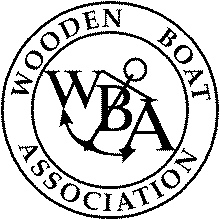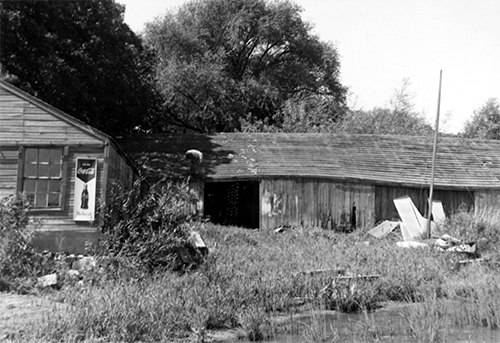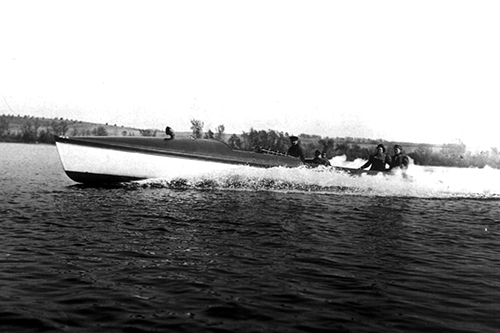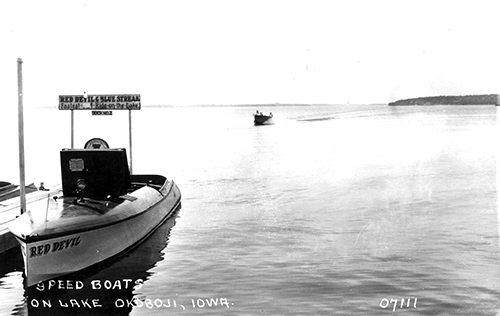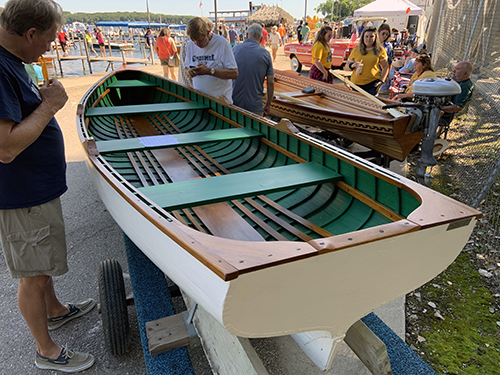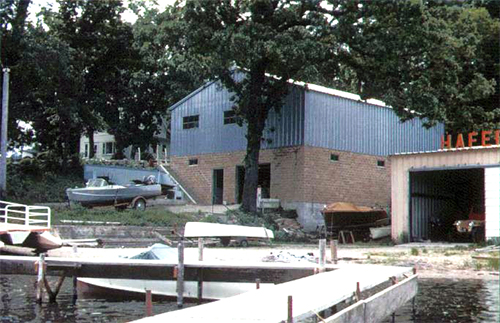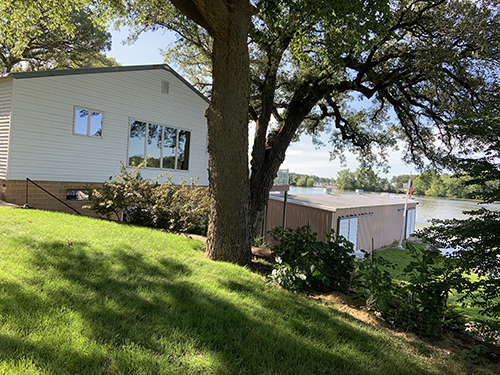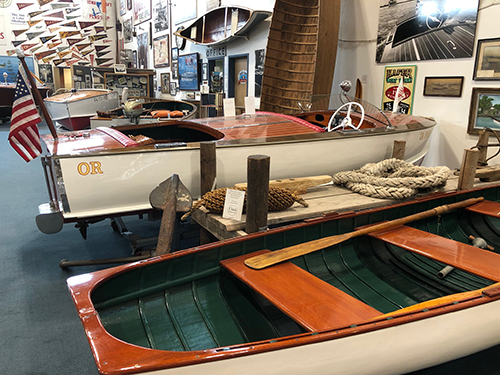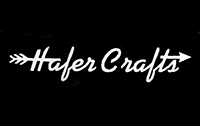
History of Hafer Craft Boats
| |
| Hafer Boats Home |
| John and Glenn Hafer Bios |
| Hafer Photos and Videos |
| Hafer Stories |
| The Iowa Great Lakes |
| Links | WBA Home Page |
70 Years of Hafer Boats |
Reprinted from "Spirit Lake Centennial", published by the Spirit Lake Beacon in 1979. Photos added. These documents provided courtesy of the Great Lakes Maritime Museum
The old Hafer Boat Works shop in Spirit Lake, after it was abandoned. Many of the residents on the lake would never buy a boat, whether rowboat, launch, or speed boat, unless it was a Hafer boat. Many of the older residents still feel that there never was a boat that could compare to the quality of a Hafer boat. The elder Hafer began by making primarily row boats and sail-boats. In a few years, he expanded to the construction of large motor boats with large cast iron engines. One of his finest works was the White Flyer, which he built in 1906. Later, the name of the boat was changed to the Francis Flyer, when "Senator" Francis bought it. The Flyer was 40 feet long and took over a month to build. In those days, according to Glenn Hafer, any boat under 24 feet was considered small.
The Hafer-built Francis Flyer, circa 1908. The engine in the Flyer was a four cylinder "Doman" engine and weighed 2,160 pounds. It was a mass of cast iron with an eight inch bore and a six inch stroke. Glenn said that the engine parts were so heavy, he couldn't even lift one of the engine's connecting rods when he was eight years old. John Hafer had about seven men working for him during peak production times. They would build about 15 of the large motor boats in a busy year and as many as 100 rowboats in a year. It seemed as though everyone on the lake shore had boats for rent and most of those boats came from Hafer. The large motor boats were built like gar fish, Hafer said, long and only six feet wide. They had to plow through the water for speed because the engines were so heavy that the boats couldn't plane over the water. The engines ran at a top speed of 550 revolutions per minute and were rated at about five horse-power. John Hafer used to drive the Flyer when motor boat races were held on West Okoboji. The races were held under a handicap system with the slower boats starting the course ahead of the faster ones. The Flyer was considered one of the faster boats, so others, such as the Oklahoma and the Merrimac, would start ahead of it. When the Flyer would start, Hafer said, his dad would run the boat slowly until he got to the finish line, then speed up and pass the other boats. Otherwise, the Flyer would be re-handicapped and would have to start even further behind the others, he added.
Hafer built a number of fast boats...including the Red Devil, "The fastest boat ride on the lake." John Hafer was also a noted sailor and won the Okoboji Yacht Club trophy three years in a row. He also built the boats he sailed. Glenn Hafer began working steadily at the Hafer Boat works in 1925. He had worked there part time since 1920. As a child he remembers when the lake level was so high that he could paddle a canoe inside the shop building, located on the lake shore. In contrast, in 1958, the lake was so low that a person could walk across the lake bottom from the boat house to the opposite shore with only a stream of water a few feet wide in the channel.
A beautifully restored 1939 Hafer "wineglass transom" rowboat/outboard boat, 2019. He also spoke of the times when the steamers would make regular trips from West Okoboji to the dock at Spirit Lake on East Okoboji. The Des Moines and the Sioux City would make runs twice a day. When they neared the East lake bridge, they would sound their whistles as a signal to open the swing bridge. Another steamer, the Hiawatha, was so slow that he and other kids would row past it. The dock at the Spirit Lake area was always busy and crowded with people when the steamers were traveling on both lakes, he said. Kids would hang around the dock all day just to watch the boats come in. The docks were actually busier than the town was. When the Hafers first came to the area, there were no houses along the shore where they built the boathouse. The entire shore was wooded and they even had to lay their own water line to the house. Over the years, the boat building industry has gone more to the large manufacturers and Glenn Hafer stopped building boats in 1960. They started the marina at Hafers in 1958 and continued it until Glenn's retirement in November, 1968.
The Hafer shop in the 1960s.
The Hafer Showroom (left) and boat shop (right) have been converted to a private home and boathouse, repectively. (2019 photo) John Hafer was awarded the Kiwanis "Citizen of the Year" award at the age of 89, in 1953. The award was presented for services to the community other than those in the boat industry. The Kiwanis members presented the award to Hafer's daughter, Mrs. John Webb. Hafer was unable to attend the awards ceremony because he was unaware of the honor and his time was taken up working on boats. Hafer served on the Spirit Lake School Board from 1910 to 1938 and was instrumental in the many improvements of the school facilities during and after his service on the board. He was the architect and building inspector for the present high school structure and was responsible for much of the athletic equipment which is still in use today. The high school football field was appropriately named "Hafer Field" in honor of John Hafer's contributions to the school. Hafer Boats -- A Lakes Area Legacy At the time John Hafer arrived in Spirit Lake early in 1894 the Okoboji and Spirit Lakes were already well established as a favorite summer playground for eager Midwestern travelers. Hafer had come to the Iowa Great Lakes with the hopes of finding work as a carpenter. And he had come at just the right time. During the first two years Hafer probably found plenty of work to occupy him in the warmer months. But when the cold winter months blew in he turned his attention to his first love--building boats. Before coming to Iowa Hafer had made several small vessels while living along the Missouri River in South Dakota. Now that he lived in a popular lakes region Hafer began building boats with a passion. In the first winter he worked in an upstairs room of his house and built several boats to sell the following summer. After two successful seasons Hafer quit work as a carpenter to concentrate his energies on building boats year around. When it came to building motor boats, Hafer insisted on the same quality for his long launches and quick runabouts. Each were built by hand, securing each board and pounding each nail with a special care and attention. For their speed boats Hafer used 3/4 inch cedar strip for the hull and topped it with beautifully polished mahogany decks. His hard work and dedication quickly became a tradition around the Lakes. Each year the number of orders put in for Hafer boats increased steadily. And it wasn't long before John Hafer's boats became the only boat most locals would consider owning. For over 70 years Hafer Boatworks painstakingly crafted each boat by hand, forsaking easier techniques of the assembly line to concentrate on the more trustworthy benefits of handmade workmanship. John passed the passion for boat building on to his son Glenn who continued his father's tradition of quality and attention to detail. Throughout the companies existence the Hafers made sure that each board was secured by nails pounded in by hand, the way Glenn had learned from his father. By the time the Hafer Boatworks closed its doors for good in 1968 it had become one of the oldest industries in Spirit Lake. In its many long years Hafer boats had created countless memories for many summer residents and had become a proud part of the Lake's history. Today someone from that era may look out across the lake, spot an old wooden boat making its way among the waves and recall fondly how the old Hafers had ushered them around the Lake's in quieter days. Among those nostalgic souls it isn't surprising to find Steve Kennedy, Captain of the Queen II and curator of the Iowa Great Lakes Maritime Museum. And when Kennedy says "I grew up around Hafer boats," you better believe it. He remembers his family had a little Hafer 45 horsepower inboard that they used to tour around the Lakes in when he was younger. And as a child he dreamed of owning a Hafer Fireball with a 90 horsepower Gray Marine engine. In college his brother worked with Glenn Hafer at Hafer Boats during the summer. As Kennedy recalls how he and his brother used to cruise the lakes with the Hafer demonstration boats searching for a cocksure Chris Craft owner to race, you can see a youthful twinkle return to his eyes. Kennedy says they would putt along slowly until someone in a Chris Craft or some other factory-made boat would come up to inspect the brand new Hafer. Soon a challenge would be issued from either side and the race would begin. More times than not, the smaller Hafers surprised the heck out of some over-confident Chris Craft owner. While Kennedy no longer issues challenges from the seats of a Hafer he still holds a fierce loyalty to the locally made Hafer Boats. "Their craftsmanship was second to none. You can talk to anybody around the lake and what they aspired to was a Hafer runabout," assures Kennedy. Presently Kennedy owns two old Hafer runabouts, a 45 horsepower runabout like the one he had as a child and a larger 75 horsepower. One of these he has donated to the Maritime Museum to add to the collection of local history which he oversees with endless enthusiasm.
Iowa Great Lakes curator Mary Kennedy, wife of the late Stephen Kennedy, added this caption in 2019: "The Hafer farthest back in this photo was Steve’s and mine. It is a 1954 utility and we named it Francis Flyer II. It was the boat we used. We even towed skiers with it. After Steve died I gave it to his oldest brother who lives in California. John had it restored and when he and his wife visit here almost every summer, it goes out of the museum and into the lake! (John worked for Glenn Hafer at the boat works). Captured in black and white for posterity, several old photographs show the famous White Flyer, one of the earliest motor boats to speed across the lakes. The boat later became known as the Francis Flyer when it was purchased by Senator Francis. Built in 1906, the 40 foot Flyer took over one month to build and held a four cylinder "Doman" engine, which weighed 2,160 pounds. Because of the size of the engines John Hafer built the early launches like gar fish, long and narrow--only six feet across from port to starboard. At the height of production Hafer's crew of seven men could turn out 15 of the larger motor boats in a busy year. These long launches were the mainstay of motors boats on the Lakes well into the thirties until the shorter runabout style replaced them in popularity. During the Second World War the production of pleasure boats was prohibited. There were still a few of the old launches around the lake when John reopened the boat works in 1945 but their time had passed. Instead the Hafer Boat works concentrated on building runabouts and in that first year after the war's end the Hafers and two other men worked around-the-clock to complete twenty-five boats for that season. One rather unique model pre-dating the war can be seen on display at the Maritime Museum. Located in a replica of an old boat house is a 1937 Hafer Craft outboard, donated by the family of the late Harold Sorensen of Estherville. According to Audrey Allen the replica faithfully duplicates her families old boat house, original contents included. And she is glad to be able to share the Hafer tradition with a larger audience than the dusty boards her families boat enjoyed only a few years earlier. Allen says the family boat was specially ordered by her father in 1937 and "it is the only one they ever made without a center deck." Back then Mr. Sorensen, who worked in Estherville as a photographer, convinced John Hafer to build the boat without the standard center deck, which provided structural stability, so he could convert the outboard motor boat into a rowboat for fishing. Occasionally Allen still uses the original ash oars when she rows around East Okoboji in her modern aluminum row boat. Even though she no longer rides in her family's Hafer, Mrs. Allen has many happy memories of the days her family would enjoy her mother's fried chicken picnics out in the middle of the lake. Another runabout built just after the war also rests proudly at the Maritime Museum. On loan from the Richard Jeffries Family this 1947 Hafer Craft Runabout is a classic example of the quality workmanship of the Spirit Lake boat works. In 1947 this beautiful hand-built wooden runabout would have taken three men one month to build and sold for $750. Powered by a 75 horsepower Gray Marine engine the boat could reach speeds of 34 M. P. H. making it one of the fastest boats on the lake during its time. Mentioning the speed of Hafer boats Dean Tuttle quickly turns the conversation to Glenn Hafer. At one time during the 1920's and thirties the young Hafer raced his boats even with the biggest names in boating. At the National Outboard Boat Races of 1929, held in Peoria, Ill., a young Glenn Hafer entered his home-made Hafer Hydroplane and finished third out of 143 entries. That day Hafer came in just behind Freddie Evinrude of the Evinrude Motors family. Both Kennedy and Tuttle take more than a little pride in the fact that the efforts of the small home-grown boat works once challenged the great names of the boating industry, adding to the legend of the Lakes and the lore of the museum. Among the museum's collection is a one-of-kind Hafer X-2 Hydroplane. Built in 1937 for Harvey Ewald of Sioux City it is the only Hafer Hydroplane ever sold to the public. Today the boat is handsomely restored to its original condition but, when it first arrived at the museum Tuttle says it came just as a pile of old boards. According to Tuttle, who spent numerous hours restoring the boat to pristine condition, only the bottom and the sides are original. But after years of neglect it now sits in the museum as a unique part of the Lake's history. Tuttle, who has worked as a Captain and chief maintenance man for the Queen II for six years, has been restoring old Hafer boats for the past several years. Over the years his respect has grown as he has become more familiar with Hafer craftsmanship "Their workmanship was superb, they did good quality work," says Tuttle. He is often surprised that the Hafer's finished product looked so polished when he sees the crude tools that they used for construction. According to Tuttle, the Hafer factory made all their own molds and castings for the boat's metal pieces out of wood. And just as each plank was nailed on by hand, each aluminum piece, from steering rod or rudder, was cast by hand.One person who has had plenty of experience in working on the old Hafer boats is Jerry Dyhrkopp of Blue Water Restoration. Before opening his own shop, where he concentrates on retooling old wooden boats, Dyhrkopp spent 33 years working on boats at Wilson Boats. "They were good boats, built here at the Lakes that a lot of people could afford," says Dyhrkopp. But from a restorers point of view he says they were built somewhat like snowflakes, "I don't know if two were ever built the same," he adds. Dyhrkopp discovered this recently while working on a 16 foot Hafer runabout. Needing to replace the side molding on an older vessel, Dyhrkopp reached into his spare parts chest and pulled out some molding from another 16 foot Hafer runabout. Unfortunately he found that the spare molding measured 16 feet one inch and thus didn't fit the slightly smaller boat. "It kind of drives you nuts, they cast all of their own hardware like a homemade construction kit," he says and if you can find the Hafer part you have to look hard for another. Despite their quirks Dyhrkopp admits Hafer craftsmanship was top of the line for their day. Dyhrkopp says he became a believer in Hafer durability while working at Wilson Boats. He remembers one day when Fred Wilson was out on East Lake testing a Hafer that had been in his shop for some repairs. According to Dyhrkopp, Wilson was running the boat near 30 m.p.h. and tinkering with the carburetor as he drove. In order to fine-tune the engine Wilson had to keep turning towards the rear of the boat for adjustments. Several workers poked their heads out of the shop just in time to see their boss, Fred Wilson run right over the top of the boat works three plank dock. There was plenty of surprise as they inspected the boat a few minutes later. The only noticeable damage was a bent blade prop and a small hole in the bow, says Dyhrkopp, not to mention the peace of mind Fred Wilson lost over the incident. If we look around us on the Lakes today it is easy to see that the time of the wooden boat has passed. They have become collectors items and show pieces, a reminder of a past when things were built to last. It would be a rare thing to spot an old Hafer boat out amongst the waves and chops of the new fiberglass hulls, but it wouldn't be unusual to stick by the craft's simple elegance and charm. Yes, the small Hafer Boatworks has had its doors closed for nearly a quarter century, but for many it still remains a place where dreams and memories were once created the old fashioned way--by hand, not machine. Almost 100 years after John Hafer first came to the Lakes as a humble carpenter we know how fortunate we are to be able witness the sturdy works of his boat building passion. [Ed. note: Steve Kennedy passed away in 2002. His beloved wife, Mary, carries on his work of curating the Iowa Great Lakes Maritime Museum.]
|
